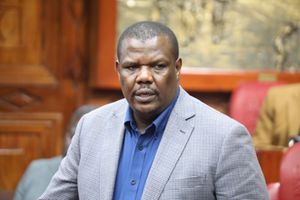Containment plot against Raila spells doom for Mt Kenya’s political future

Deputy President William Ruto. Ruto’s UDA has created a powerful fighting force to barricade Mt Kenya region from Azimio la Umoja.
The ongoing battle for the soul of the Mt Kenya region ahead of the August 2022 General Election has eerie echoes in America’s containment strategy in the Cold War era.
The overarching aim of this strategy is to enable Deputy President William Ruto to keep intact the Kikuyu-Kalenjin coalition that won the 2013 and 2017 elections.
Ruto’s United Democratic Alliance (UDA) is keen to prevent former Prime Minister Raila Odinga from making inroads into the Mountain region.
The strategy, rolled out after the March 2018 ‘handshake’ between Odinga and President Uhuru Kenyatta, spells doom for Mt Kenya politics and development.
The divide-and-conquer aspect of this strategy has effectively turned the region into a perfect ‘Power of Babel’, plunging it into a political abyss from which it might take generations to emerge.
The UDA containment strategy in Mt Kenya rests on five campaign planks.
First, it seeks to keep intact the Kalenjin-Kikuyu détente by fighting and neutralising Kenyatta and replacing him with Ruto as Mt Kenya’s new kingpin. This strategy has heaped all the real and assumed failures of Kenya’s fourth presidency on the doorsteps of the President while claiming all the credits for Jubilee’s achievements.
Ruto and his men imagine themselves as ‘revolutionaries’ waging war against the modern-day ‘ancient regime’ of the French Revolution.
They are preying on the divisive class divide between the rich (‘dynasties’) and the poor (‘hustlers’) and tapping into the veins of populism based on a hypothetical model that exploits the poverty and economic woes.
As the region’s youth bulge morphs into an existential threat, hustler populism is riding on the tidal wave of youth unemployment, poverty, drug addiction and alcoholism. The socioeconomic impact of the Covid-19 pandemic is a windfall for hustler strategy.
Second, the hustler narrative seeks to neuter Kenyatta’s big tent or catch-all unity movement and scuttle the nationalist coalition between him, Odinga and others.
In fighting Odinga, the ‘hustlers’ have discerningly adopted and amplified anti-Raila rhetoric that dominated poll campaigns in the Mountain region in 2007, 2013 and 2017.
Third, the hustler strategists have created a powerful fighting force to barricade the region from Azimio la Umoja. A team of political loyalists comprising MPs, governors and women representatives is their foot soldiers.
Recently, Ruto’s men have fuelled high-profile political defections to foster the public perception that the whole of Mt Kenya is Hustler territory.
Moreover, UDA is decidedly feminising Mt Kenya’s leadership by backing to the hilt a new pliant women leadership as soft fronts for an iron-clad behind and as a long-term strategy of weakening the region’s politics.
Fourth, UDA strategists have shrewdly distanced the party from Kalenjin politicians. Instead, they have hired elements of the political class in the Mt Kenya, Eastern and coastal Kenya to market the party to pre-empt accusations that it is a Kalenjin party.
At the same time, they have wielded a heavy stick against Kalenjin rebels and launched a vicious assault on Kanu and Gideon Moi to weaken their influence in the Kenyatta succession.
Fifth, the containment strategy is soared by a powerful campaign juggernaut hoisted on two main pillars.
Favourable sermons
The first one comprises bishops, pastors and other religious leaders – particularly in evangelical churches – across the region who are said to be receiving huge amounts as incentives for favourable sermons, including mentioning 'bottoms-up', ‘William Ruto’, ‘Hustler Nation’ or ‘UDA’ during their services.
This is meant to condition worshippers in the region to believe that Ruto is a “God-fearing” leader and one of them and that he is Godsent to save Kenya from poverty and dynasties!
Two, as Raila begins to make serious inroads into the region, one social media source claimed that Rift Valley billionaires had upped the ante, giving well-known musicians, radio and TV personalities, comedians and influencers in the region ‘offers they cannot refuse’ to promote the hustler agenda.
Influencers in the races for political offices have also been promised free UDA nomination certificates, campaign materials and jobs in case they lose.
Hustler politics is systematically demobilising the powerful political machine in Mt Kenya that propelled Mwai Kibaki and Uhuru Kenyatta to power.
As a result of the tragic proliferation of dysfunctional briefcase parties in Kenya – which has 83 registered parties compared to 22 in Tanzania and 26 in Uganda – the region lacks one galvanising party, unlike other parts of the country.
The once mighty Democratic Party (DP), Party of National Unity (PNU), The National Alliance (TNA) and Jubilee Party are pale shadows of their past glory and power. It might take another whole generation for the region to recover and rebuild this power machine.
As cranks and charlatans replace the ‘philosopher kings’ and technocrats of the past, the region has lost its capacity for long-term strategic thinking.
Therefore, the region risks losing its ability to harness its immense potential. Already, a new East-West ethnic divide has emerged in the region, reflecting a brutal surge of micro-nationalism and parochialism in the counties.
According to the 2019 census, the region’s 10 counties have a total population of 10.7 million people, a GDP of Sh2.12 trillion, nearly 35 per cent of Kenya’s voting power and contributes over 26 per cent of the national GDP, the largest share of the country’s economy.
Globally, it would rank number 113 out of 195 world states! Not surprisingly, the regional bloc, which hosted the new British High Commissioner to Kenya, Ms Jane Marriot last year, is firmly on the radar screen of the EU and UK post-Brexit strategy.
Sadly, the region’s strategically weak power elite failed to secure the Building Bridges Initiative (BBI), which would have given the region no less than 53 billion every year (more than half a trillion shillings over the next 10 years). The region lost nearly 50 per cent of the $13 billion the United States offered as Marshall Plan to rehabilitate European post-war economies!
By and large, the region has settled for the second fiddle in the 2022 presidential race. But it also risks not getting the Deputy President’s position.
After Mudavadi and Wetang’ula joined the Hustler train, Ruto is under immense pressure to give the No.2 position to the Luhya.
If Ruto completely vanquishes Uhuru and becomes the region’s new kingpin, he will re-engineer a winning formula by appointing his Deputy from Ukambani or Western.
Professor Peter Kagwanja is a former Government Adviser and now the Chief Executive of Africa Policy Institute (API)





